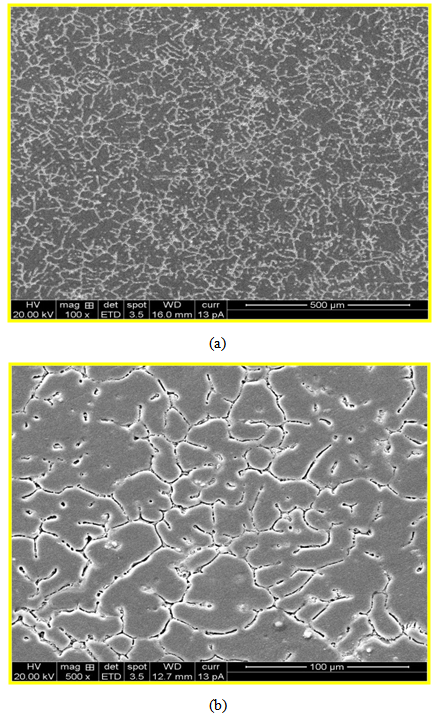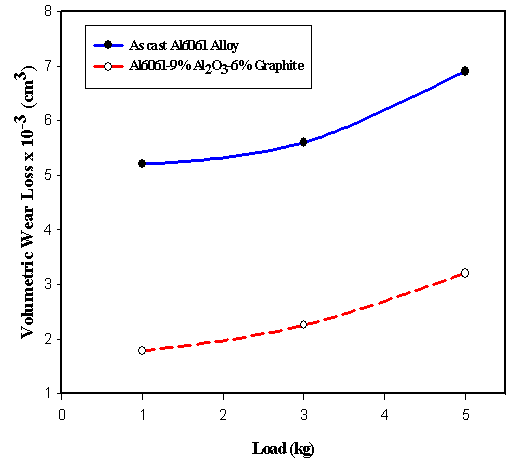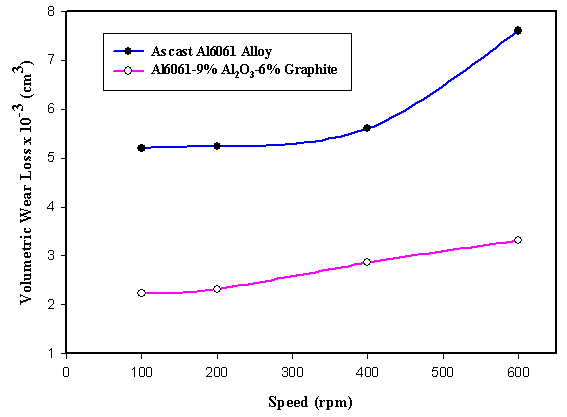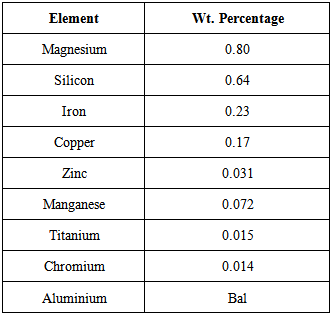-
Paper Information
- Next Paper
- Previous Paper
- Paper Submission
-
Journal Information
- About This Journal
- Editorial Board
- Current Issue
- Archive
- Author Guidelines
- Contact Us
American Journal of Materials Science
p-ISSN: 2162-9382 e-ISSN: 2162-8424
2015; 5(3C): 25-29
doi:10.5923/c.materials.201502.05
Wear Behavior of Al2O3 and Graphite Particulates Reinforced Al6061 Alloy Hybrid Composites
Madeva Nagaral 1, V. Auradi 2, K. I. Parashivamurthy 3, S. A. Kori 4
1Aircraft Research and Design Centre, HAL, Bangalore, India
2Department of Mechanical Engineering, Siddaganga Institute of Technology, Tumkur, India
3Department of Mechanical Engineering, Govt. Engineering College, Chamarajnagar, India
4Department of Mechanical Engineering, Basaveshwar Engineering College, Bagalkot, India
Correspondence to: Madeva Nagaral , Aircraft Research and Design Centre, HAL, Bangalore, India.
| Email: |  |
Copyright © 2015 Scientific & Academic Publishing. All Rights Reserved.
This paper deals with the fabrication and evaluation of wear properties by introducing micro size Al2O3 and Graphite particulates into Al6061 alloy matrix. Al6061 alloy based hybrid metal matrix composites were prepared by stir casting method. 9 wt. % of Al2O3 and 6 wt. % of graphite were added to the base matrix. For each composite, the reinforcement particles were pre-heated to a temperature of 600 degree Celsius and then dispersed in steps of two into the vortex of molten Al6061 alloy to improve wettability. The Microstructural study was done by using Scanning Electron Microscope (SEM), which revealed the uniform distribution of Al2O3 and Graphite particles in matrix alloy. A pin-on-disc wear testing machine was used to evaluate the volumetric wear loss of prepared specimens, in which a hardened EN32 steel disc was used as the counter face. The results revealed that the volumetric wear loss was increased with increase in normal load, sliding speed and sliding distances for all the specimens. The results also indicated that the volumetric wear loss of the Al6061-9% Al2O3-6% Graphite composites were lesser than that of the Al6061 matrix. The worn surfaces were characterized by SEM microanalysis.
Keywords: Al6061 alloy, Wear, Al2O3, Graphite, Stir casting, Hybrid composites
Cite this paper: Madeva Nagaral , V. Auradi , K. I. Parashivamurthy , S. A. Kori , Wear Behavior of Al2O3 and Graphite Particulates Reinforced Al6061 Alloy Hybrid Composites, American Journal of Materials Science, Vol. 5 No. 3C, 2015, pp. 25-29. doi: 10.5923/c.materials.201502.05.
Article Outline
1. Introduction
- Aluminium and its alloys have continued to maintain their mark as the matrix material most in demand for the development of Metal Matrix Composites (MMCs) [1-3]. This is primarily due to the broad spectrum of unique properties it offers at relatively low processing cost. Some of the attractive property combinations of Al based matrix composites are: high specific stiffness and strength, better high temperature properties, thermal conductivity, and low thermal expansion [4-5].As a result of this, these materials are found to be used in mechanical components such as gears, cams, wheels, impellers, brakes, clutches conveyors, transmission belts, bushes and bearings [6-7]. In most of these services the components are subjected to tribological loading conditions. There are several fabrication techniques available to manufacture MMC materials but there is no unique route in this respect. Due to the choice of material and reinforcement and types of reinforcement, the fabrication techniques can vary considerably. There are two types of fabrication methods available i) solid phase fabrication method includes diffusion bonding, hot rolling, extrusion, drawing, explosive welding, powder metallurgy route, and pneumatic impaction ii) liquid phase fabrication method includes liquid metal infiltration, squeeze casting, compo casting, pressure casting and spray co-deposition [8]. The preparation of such Al based composites by melting and casting routes i.e. stir casting is by far the most economical one, but is associated with some inherent problems arising mainly from both the apparent non wettability of Al2O3 and graphite by liquid aluminium alloys [9] and the density differences between the two materials. Therefore, the introduction and retention of hard ceramic particles like Al2O3 and soft particles like graphite in the molten aluminium is extremely difficult [10]. Poor wettability and density differences also results in poor recovery of graphite particles in aluminium melt. Good wetting is an essential condition for the generation of a satisfactory bond between particulate reinforcements and liquid metal during casting to allow transfer and distribution of load from the matrix to the reinforcements without failure [11]. In the present work an attempt has been made to improve the wettability of reinforcement particles with aluminium by adding particles in two steps into the matrix.Hard ceramic particulates such as zirconia, alumina and SiC have been introduced into aluminium based matrix in order to increase the strength, stiffness, wear resistance, fatigue resistance. Among these reinforcements Al2O3 is compatible with aluminium and forms good bond with the matrix. Umanath [12] studied the wear behavior of Al6061-SiC-Al2O3 composites. The results indicated that the wear resistance of the 15% hybrid composite is better than that of 5% composite. Babu [13] investigated the wear behaviour of graphite nanofiber and aluminium composites and identified the effect of applied load and sliding speed on wear.Naplocha [14] reported the tribological properties of Al-Saffil-C hybrid metal matrix composites with various amounts of graphite and alumina produced by squeeze casting method. It revealed that reinforcing a composite with Al2O3 fibres prevents adhesion and seizure, especially under high pressure than 1 MPa.Previous researchers revealed, at small amount of graphite contents poor lubrication and small matrix weakening occur. With increasing graphite content, the created graphite film completely separates the wear couple and at the same time protects the matrix, still resistant to plastic deformation. When graphite content exceeds a certain threshold level, weakening of the matrix is so much advanced that the lubricant film is no longer able to protect it effectively, so deformation and cracking are the prevailing phenomena. This graphite content plays an important role to determine the properties of composite. In this study, an attempt has been made to prepare Al6061 alloy composites by adding 9 wt. % of Al2O3 and 6 wt. % of Graphite particulates into matrix by using a novel two stage reinforcement addition method. The graphite content is limited to 6 wt. % to enhance the influence of graphite effect on wear behavior of composites. Further, the prepared Al6061-Al2O3-Graphite composites were studied for effect of load and sliding speed on the wear properties by using pin-on-disc wear testing machine.
2. Experimental Details
2.1. Materials Used
- Metal matrix composites containing 9 weight percentages of Al2O3 and 6 wt. % of graphite particles were produced by liquid metallurgy route. For the production of MMCs, an Al6061 alloy was used as the matrix material while Al2O3 and graphite particles with an average size of 90-125µm were used as the reinforcements. The chemical composition of the alloy used in the present investigation is given in Table 1.
|
2.2. Preparation of Composites
- The Al2O3-graphite-particle reinforced Al6061alloy hybrid metal matrix composites have been produced by using a vortex method. Initially calculated amount of Al6061 alloy was charged into SiC crucible and superheated to a temperature 720°C in an electrical resistance furnace. The furnace temperature was controlled to an accuracy of ±50 degree Celsius using a digital temperature controller. Once the required temperature is achieved, degassing is carried out using solid hexachloroethane (C2Cl6) to expel all the absorbed gases. The melt is agitated with the help of a zirconia coated mechanical stirrer to form a fine vortex. A spindle speed of 250 rpm and stirring time 5-8 min. were adopted. The Al2O3 and graphite particulates were preheated to a temperature of 250 degree Celsius in a pre-heater to increase the wettability. The pre-heated Al2O3 and graphite particles introduced into melt in steps of two at constant feed rate of 1.2-1.4 g/sec. Two stage additions involve dividing entire weight of reinforcement into two equal weights and then individual weights are added to the melt in two steps rather than adding all at once. At every stage, stirring is carried out before and after introduction of reinforcement to avoid agglomeration and separation of particles and to ensure homogeneous dispersion of Al2O3 and graphite particles in the melt. After holding the melt for a period of 5 min., the melt was poured from 710 degree Celsius into a preheated cast iron mould having dimensions of 120mm length x 15mm diameter. Wear specimen of size 25mm length and 8mm diameter was prepared by using castings made.
2.3. Dry Sliding Wear Test
- Dry sliding wear tests were carried out on Al6061 alloy and Al6061-Al2O3-Graphite composites using a pin-on-disc wear test apparatus. Cylindrical pin specimens of 8 mm diameter and 25 mm length were mounted vertically on a pin holder. The end of specimens were polished with abrasive paper of grit size 600 and followed by grade 1000. During the test the pin was pressed against the counterpart EN32 steel disc with hardness of 60 HRC. Prior to each run, the steel counter-face was ground with 320grit and then 600grit SiC abrasive for few minutes followed by cleaning with acetone. Test conditions included load-speed settings of 100, 200, 400 and 600 rpm under a 5kg normal load, and 1, 3 and 5kg loads at 400rpm speed. The initial weight of the specimen was measured in an electronic weighing machine with ± 0.01mg accuracy. Data collected and analyzed for wear rates in the form of weight loss.
3. Results and Discussion
3.1. Microstructural Studies
- Figure 1 (a-b) shows the SEM microphotographs of Al6061 as cast and Al6061 with 9 wt. % of Al2O3 and 6wt. % of graphite particulate composites. This reveals the uniform distribution of Al2O3 and graphite particles and very low agglomeration and segregation of particles, and porosity. The vortex generated in the stirring process breaks solid dendrites at 640degree Celsius due to higher friction between particles and Al matrix alloy, which further induces a homogeneous distribution of particles.
 | Figure 1. Showing the SEM microphotograph of (a) as cast Al6061 alloy (b) Al6061-6% Al2O3-6% graphite composites |
3.2. Wear Behavior of Materials
- The variation of volumetric wear loss is as shown in figure 2. Applied load affects the wear rate of Al-Alloy and the composites significantly and is the most dominating factor controlling the wear behavior. The volumetric wear loss varies with the normal load which is an indicative of (Archardi’s law), and is significantly lower in case of composites.
 | Figure 2. Shows the volumetric wear loss of as cast Al6061 alloy and its composites at constant sliding speed 400 rpm and varying loads |
 | Figure 3. Shows the volumetric wear loss of as cast Al6061 alloy and its composites at constant load 5Kg varying speeds (rpm) |
3.3. Wear Worn Surface Study
- Wear surface analysis of hybrid composites were examined by scanning electron microscope. Figure 4 represents the wear surface of as cast Al6061 alloy and specimens containing 9 wt. % of Al2O3 and 6 wt. % of graphite particles reinforced composite at 5 kg load and 400rpm sliding speed. Figure 4a shows the worn surface of the Al6061 matrix alloy reveals several patches of damaged portions and deep grooves due to heavy plastic deformation. It can be seen that the grooves are deeper in the case of as cast alloy compared to that of composite.Figure 4b shows the SEM image of the worn surface of Al6061-9% Al2O3-6% Graphite composite tested at applied load of 5kg and 400rpm speed. The grooves are very small due to the hard nature of Al2O3 reinforcement and poor wear losses. Worn surface shows less cracks and grooves mainly due to the presence of graphite particulates. The smeared graphite particles from the worn surface of composites form a thin rich tribolayer between sliding surfaces, which prevent direct metal contact. This is clearly indicates that volumetric wear loss can be related to the presence of graphite film layer, which may serve as a protective layer between disc and specimen. This film prevents the breaking of hard Al2O3 particles from the pin surface, which results in less damage to the surface.
 | Figure 4. Shows the SEM microphotographs of worn surfaces of (a) as cast Al6061 alloy (b) Al6061-9% Al2O3-6% Graphite composites at 5kg load and 400rpm |
4. Conclusions
- The present work on processing and evaluation of Al6061-9% Al2O3-6% graphite metal matrix composite by melt stirring has led to following conclusions. Al6061 alloy based composites have been successfully fabricated by melt stirring method using two stage addition method of reinforcement combined with preheating of particles. The SEM microphotographs of composites revealed fairly uniform distribution of reinforcement particulates in the Al6061 alloy metal matrix. The microstructure of the composite contained the primary α-Al dendrites and eutectic silicon with Al2O3 and graphite particles separated at the inter-dentritic region. The addition of Al2O3 and graphite particles to Al6061 alloy matrix improves the wear resistance of the composite. The volumetric wear loss is dominated by load factor and sliding speed. The increase of loads and sliding speeds leads to a significant increase in the wear loss. The Al6061-9% Al2O3-6% graphite composites have shown lower rate of volumetric wear loss as compared to that observed in as cast Al6061 alloy matrix. SEM micrographs of worn surface revealed the presence of smooth grooves in the Al6061-Al2O3-graphite composite compared to the base matrix.
 Abstract
Abstract Reference
Reference Full-Text PDF
Full-Text PDF Full-text HTML
Full-text HTML